How to Write Testimonials – Easy Guide
Let’s start with a simple exercise: visit any page on your website and take note of the marketing claims you’ve made. How often do you describe your business as easy, smart, effective, trusted, or reliable? Is it half a dozen times, ten times, or even more? Now, try this: review the same page and count how many times you’ve backed up these claims with solid evidence. How many data points, statistics, case studies, and testimonials are present? Do you have just a couple of these, five, or perhaps none at all? Chances are, there might not be many.
Here’s the key point: every marketing claim you make should be substantiated with supporting evidence. And the most straightforward and effective way to add credibility to your website is through testimonials. In this comprehensive guide on website testimonials, we’ll address some essential questions: where to place them, how to craft testimonials, strategies for collecting testimonials, and why testimonials are such potent tools. Along the way, we’ll include real customer testimonial examples to illustrate the concepts. Let’s begin with the fundamentals.
The Power of Testimonials
Why Are Testimonials Important?
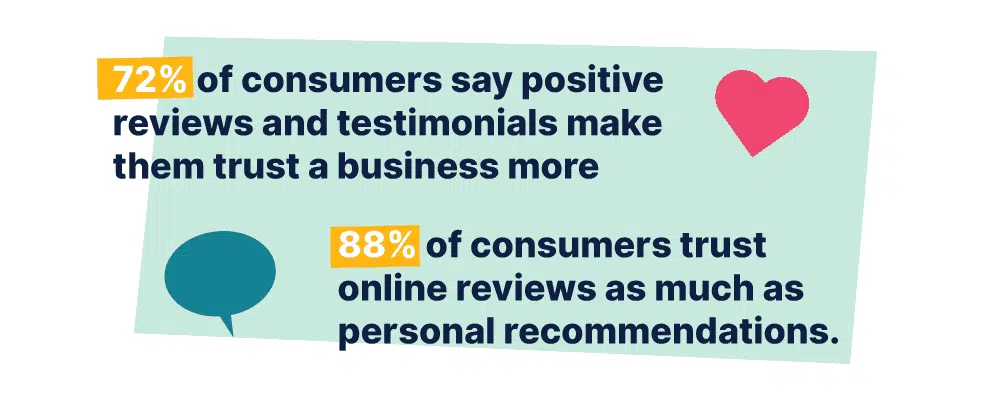
In a world saturated with information, testimonials act as social proof. They help build trust, credibility, and authority by showcasing real experiences. A positive testimonial can influence potential customers or partners to make a decision in your favor.
Sharing customer reviews on social media is a powerful way to establish your credibility and build trust with potential leads and customers. When you put yourself in the customer’s shoes, it becomes evident why this practice is so essential, especially when you’re in the market for a professional, trustworthy real estate agent to sell a property you’ve owned for a decade. The choice becomes clear – would you trust a real estate business with zero posted reviews, or would you opt for a different company that boasts 25 glowing reviews? It’s a no-brainer!
Research reinforces the significance of customer reviews. An impressive 72% of customers admit that positive reviews and testimonials play a pivotal role in making them trust a business more. What’s more, a whopping 88% of consumers trust online reviews just as much as personal recommendations. This trust in online reviews underscores the potential of sharing positive customer feedback on social media platforms.
By sharing these testimonials and reviews, you’re not just demonstrating the credibility and success of your business; you’re also tapping into a potent tool for building trust and connecting with your social audience. So, the next time you receive a positive review, consider sharing it on your social media channels to showcase your reputation and competence. It’s a strategy that can pay remarkable dividends in today’s digital age.
How Testimonials Benefit You
Testimonials not only benefit the recipient but also the person providing the endorsement. By writing a thoughtful testimonial, you can strengthen your professional relationships, expand your network, and establish yourself as an authority in your field.
How to Write Testimonials
Crafting a Genuine Testimonial
The key to an effective testimonial is authenticity. Your words should reflect your true experiences and emotions. Use conversational language and keep it genuine. The more authentic your testimonial, the more impact it will have.
Structure of a Testimonial
- Introduction: Begin by introducing yourself and explaining your connection to the person or business.
- Highlight the Positive: Share the specific aspects or experiences that impressed you. Be detailed and specific.
- Overcome Objections: Address any potential objections or concerns that others may have.
- Conclude with a Strong Recommendation: Summarize your positive experiences and endorse the person or business enthusiastically.
Utilizing LSI Keywords
When crafting your testimonials, subtly incorporate LSI (Latent Semantic Indexing) keywords that are relevant to the person or business you’re endorsing. This can help boost the SEO value of the testimonial without being overly obvious.
Expert Tips for Writing Testimonials
Focus on the Beneficiary
Keep in mind that testimonials are meant to benefit the recipient. Highlight how your interaction with the person or business improved your life or solved a problem.
Include Specific Details
Instead of generic praise, provide specific examples and anecdotes. For instance, mention how a product solved a particular issue or how the person’s services led to a positive outcome.
Add a Call to Action
Encourage readers to take a specific action after reading your testimonial. Whether it’s trying out a product, contacting the person, or making a purchase, a call to action can be powerful.
Keep it Concise
While details are essential, avoid making your testimonial excessively long. Aim for clarity and brevity, so readers can quickly grasp the main points.
Why are testimonials effective?
Effective testimonials play a crucial role in increasing your conversion rates. Here are the benefits they bring:
Build Trust: Testimonials act as third-party endorsements, which naturally build trust. When potential customers see others praising your product or service, it triggers what’s known as the conformity bias or bandwagon effect. People tend to follow the crowd, and when they see positive testimonials, they’re more likely to trust your brand.
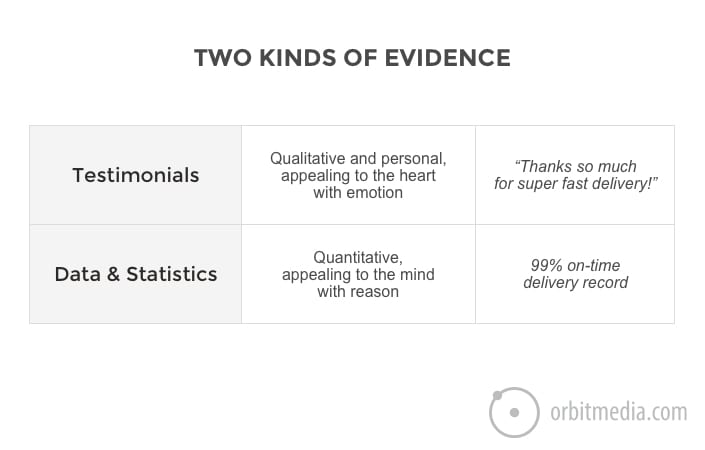
Social Proof: Testimonials are a vital form of social proof, which is one of the two types of evidence you can use on your website to bolster your credibility. Social proof demonstrates that others have had a positive experience with your offering, making it more appealing to new customers.
To create a truly compelling website, it’s advisable to use both testimonials and endorsements. However, starting with testimonials is a wise choice. It’s important to note the distinction between endorsements and customer testimonials. An endorsement typically involves a well-known influencer publicly supporting a brand, while a testimonial comes from an actual customer or client. The testimonial might feature an unknown person to the reader, but it carries the weight of authenticity because it reflects their personal experience as a paying customer, akin to a review.
How to get a great testimonial
There are two methods to obtain testimonials: requesting them and capturing them organically as they come in. The first approach is quicker, while the second is more straightforward.
1. Asking for testimonials
Initiate the process by reaching out to your most ardent supporters – those delighted clients and customers who have previously indicated their readiness to offer a testimonial. They might be eager to assist you in this regard. Here’s a sample email you can use to solicit a testimonial:
“Hello, Bob. I hope this message finds you well. I’m writing to kindly request your assistance in providing us with a brief testimonial for our website. We’re currently in the process of updating a few web pages, and we believe that your testimonial would greatly contribute to our online presence. In return, we’d be more than happy to include a link to your website, which can have a positive impact on your site’s SEO.
If, however, you feel uncomfortable with this request in any way, please don’t hesitate to let us know. We completely understand and respect your decision. If you’re open to it, we can either draft a short testimonial for your review, or you can simply provide a sentence or two. The choice is yours, and we want to make the process as effortless as possible for you.
Your contribution would mean a lot to us, Bob. Thank you for considering our request.”
A crucial point to remember is to never attribute a testimonial to someone without their explicit review and approval, as doing so is not only inauthentic but also illegal. Instead, create a draft testimonial and allow your customer to make any necessary revisions and give their final approval.
Let’s break down this communication. It’s vital that the email is concise, respectful, and easily answerable, regardless of whether they decide to cooperate or not. As an added incentive, the offer incorporates a link to their own website, which can significantly benefit their SEO. Assuming they have a good understanding of how links affect search engines, if not, you can provide them with a video tutorial explaining the process.
Offering such a straightforward and mutually beneficial opportunity is difficult to turn down. Should they accept, it’s imperative to express your gratitude in a meaningful way. A simple thank-you email won’t suffice. It’s a great idea to go the extra mile with a handwritten note, a LinkedIn recommendation, or some other unexpected gesture to genuinely convey your appreciation.
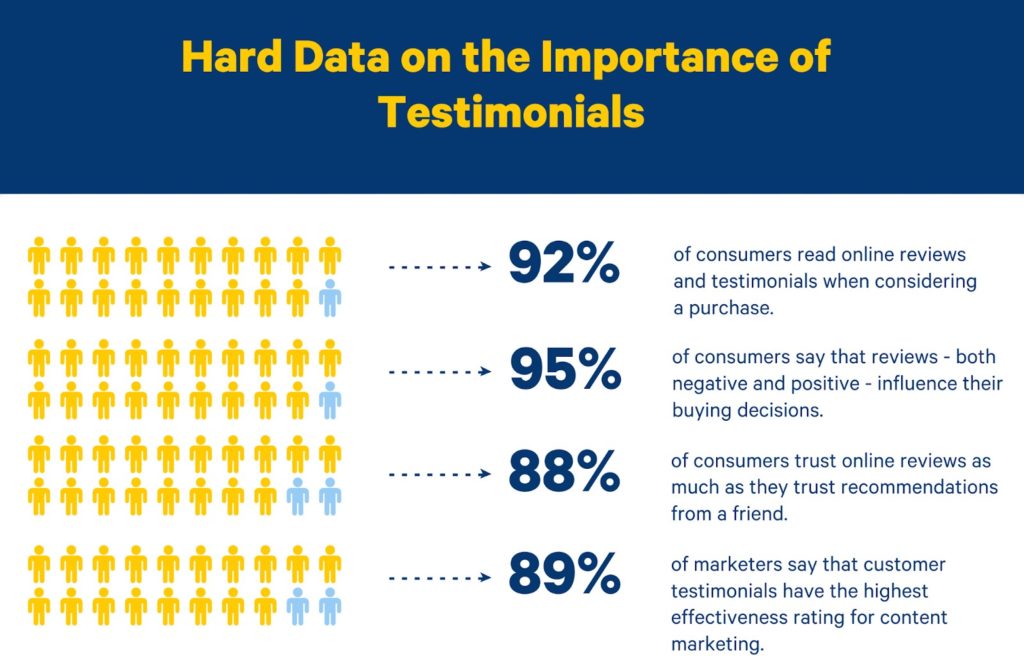
2. Listening for testimonials
Testimonials are a part of daily life, or at least the beginnings of them are. A savvy marketer knows how to identify these beginnings. Here’s what they typically look like:
- Grateful Email Messages: Messages expressing gratitude like, “Thank you so much for a job well done.”
- Social Media Appreciation: Posts on social media platforms that show love and support, such as, “You guys are the best! Keep up the great work!”
- Handwritten Thank You Notes: Sincere handwritten notes that convey appreciation, like, “I just wanted to let you know that it’s been great working with you.”
- In-Person Expressions of Gratitude: Face-to-face interactions where someone expresses their gratitude, such as, “You’ve been so helpful. Is there anything I can do for you?”
If you’re effective in your role, you’ll come across these expressions of gratitude from time to time (if you don’t, it’s essential to address more significant issues before focusing on testimonials). The key is to recognize these moments and then take the time to leverage them effectively.
Here’s how you can make the most of them:
- Save them in a “Good File”: Create a folder or document where you can collect emails or screenshots of these appreciative moments.
- Respond Promptly: Reach out with a reply immediately, expressing your gratitude for their kind words. Ignoring these messages would be impolite.
- Request Permission: If it’s appropriate, ask the sender if they would be willing to allow you to use their words as a testimonial on your website.
If the positive message you identified was more about you personally rather than the company you work for, consider asking the person to recommend you on LinkedIn. This is often the key to receiving LinkedIn recommendations. Just make a polite request at the right moment.
Now that we know how to spot these moments and how to request them, let’s discuss who should write the testimonials, which depends on the source. Here are some writing tips:
- From Emails or Messages: If the testimonial originates from emails or messages, you can draft it yourself using the kind words provided and then ask for the person’s approval. Make sure it aligns with their sentiments.
- Social Media Posts: When testimonials are in the form of social media posts, you can ask the person if they would mind reposting their message on a dedicated testimonials page or providing a similar statement that you can use on your website.
- Handwritten Notes: If the testimonial comes from a handwritten note, it’s best to respect its authenticity. Ask the sender if they would be comfortable with you sharing the sentiment and consider turning it into a visual testimonial on your website.
- In-Person Gratitude: For testimonials expressed in person, ask the individual if they would be willing to summarize their thoughts in written form or provide a statement for your website. Ensure it accurately reflects their in-person praise.
Remember that authenticity is crucial in testimonials, so make sure that the final testimonial genuinely represents the individual’s feelings.
How are testimonials written?
Effective writing is crucial when it comes to creating great testimonials. Here are three writing tips to ensure your testimonials are impactful and effective:
- Keep It Short: Long-winded testimonials are unlikely to be read by your website visitors. For instance, consider this lengthy testimonial: “I just wanted to share a quick note and let you know that you guys do a really good job. I’m glad I decided to work with you. It’s really great how easy your websites are to update and manage. I never have any problem at all. My new site is so much faster and easier to work with than my old site. It used to take me an hour or more to update a page, and I would still sometimes screw things up. Now, it’s almost like having a designer right here with me. I just choose the page, make the change, and click save. It’s so simple. Thanks, guys!”
While this testimonial might be glanced at, it’s unlikely to be thoroughly read. Therefore, it’s important to keep testimonials short, preferably within 30-50 words. Pro Tip: If you have longer testimonials, consider highlighting the most impactful words or phrases to draw visitors’ attention to the most important parts.
- Be Direct: Start your testimonial with the most compelling statement. Ensure that even if someone only reads the first few words, they grasp the essence of the testimonial. To illustrate, let’s revise the previous example to make it shorter and more direct: “You made it so simple. My new site is so much faster and easier to work with than my old site. I just choose the page, make the change, and click save. Thanks, guys!”
Ask yourself: Which words in the testimonial carry the most impact? Which words align best with the hopes and fears of your website visitors? Place those words at the beginning of the testimonial to capture the reader’s attention.
- Be Authentic: Everything you write and say is perceived as marketing, and your audience is aware of it. However, when your customers express their thoughts, their candor can be unexpectedly refreshing and candid. It’s nearly impossible for a marketer to produce copy as authentic as a genuine customer. Take a look at this example: “Wow. I just updated my site, and it was SO SIMPLE. I am blown away. You guys truly kick ass. Thanks for being so awesome. High fives!”
This tone is so authentic that it’s disarming. Don’t attempt to mimic this style in your writing. Instead, let your customers convey their sentiments in their own words. Remember, “When you say it, it’s marketing. When they say it, it’s social proof.”
What should testimonials include?
Incorporating more information into a testimonial increases its credibility. Testimonials are most effective when they include the person’s name, title, company, and a picture. Testimonials with just the person’s initials are the least credible. Let’s compare these examples:
Example 1: “Your product is amazing! – AB”
Example 2: “Your product is amazing! – John Smith, Marketing Manager at XYZ Corp”
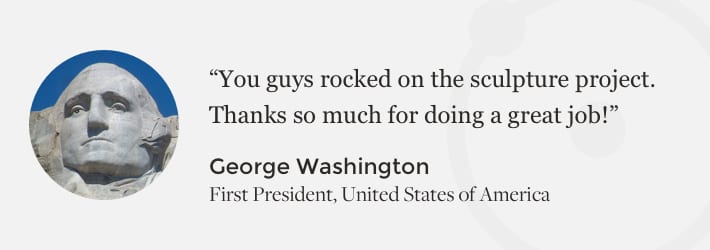

The testimonial text is the same in both examples, but which one appears more credible, trustworthy, and compelling? The key difference is the presence of a face. Including a person’s photograph in testimonials makes them more personal and authentic. Images of people’s faces have a significant impact in marketing and are a fundamental strategy in neuromarketing web design. Basecamp conducted an A/B test that demonstrated how including a happy customer’s face increased conversion rates by 102.5%.
Therefore, it’s clear that including a person’s name, title, company, and especially their photo can significantly enhance the credibility and effectiveness of a testimonial.
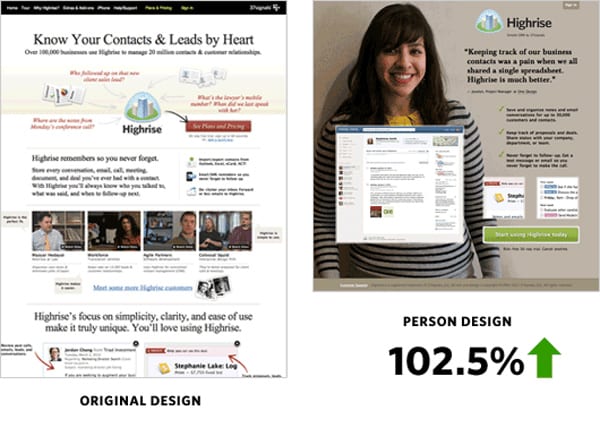
(source: Behind the scenes: A/B testing part 3Opens a new window)
When clients are unwilling to allow you to use their names or company names in testimonials, it can be a common challenge. While there’s no perfect solution, you can anonymize the testimonial by using initials and specifying their industry. This approach, although not ideal, is better than having no testimonials at all.

However, if you face difficulties in obtaining traditional testimonials, there are alternative forms of evidence that can be added to your website to build trust and credibility with your audience. Testimonials are valuable, but there are other options to consider.
 |
“We know that more than 92% of all consumers and approximately 84% of all B to B buyers report that a ‘recommendation’ from someone they trust is the top influence on their purchase decision. (sourceOpens a new window)
So, clearly, recommendations and testimonials are vital. However, many companies don’t allow their employees to publicly endorse products or services – and many consumers don’t make the time to recommend. There is another way. Research tells us that simply having someone ‘like’ or ‘share’ your content is regarded by many as an endorsement. And, if you bring customers in for a roundtable discussion – with moderators and experts – and share that content (with permission, of course), it is also often regarded as an endorsement.” – Paul M. Rand, @paulmrand, President/CEO of Critical Mass/ZocaloOpens a new window and author of ‘Highly Recommended’Opens a new window (McGraw-Hill). |
Finally, here’s a super powerful tip from Jen Havice on one more thing to add to your testimonials:
 |
“The best way to give your testimonial a boost is by adding a compelling summary sub-headline above it. This could be as simple as pulling a powerful quote from a longer testimonial or creating your own copy that nicely sums up the value of the testimonial.
By adding a sub-headline, you’ll not only draw more attention to your testimonial but entice your visitor to actually read what should be your most powerful form of social proof on your site.” – Jen Havice, @jenhavice, Conversion Copywriter, Make Mention MediaOpens a new window. |
When it comes to adding testimonials to your website, the conventional wisdom might surprise you: “Never make a testimonials page. Make every page a testimonials page.” The reason for this approach is quite straightforward. Visitors typically avoid testimonials pages, as they often expect nothing more than a sales pitch. These pages tend to receive far less traffic compared to other pages on your site, and thus, they may not effectively showcase your social proof.
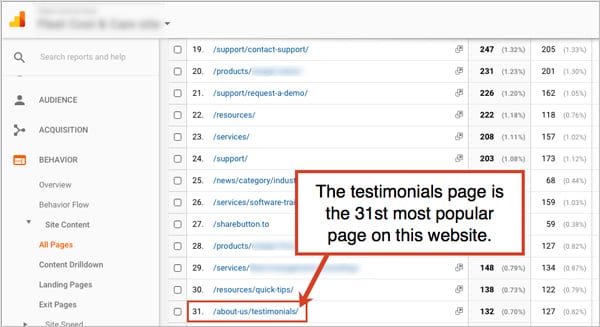
Instead, here are three guidelines on where to strategically place your testimonials to make the most of them:
- Strategically Within Content: Embed testimonials within the content where they are most relevant. For example, if you have a testimonial that speaks to the effectiveness of a specific product or service, place it on the corresponding product or service page. This approach provides context and adds credibility to the content.
- Homepage: Display a select few compelling testimonials on your homepage. These should be concise and impactful to grab visitors’ attention as soon as they arrive at your site. This primes them for a positive experience from the start.
- On Conversion Pages: Place testimonials on key conversion pages, such as your product or service order forms, checkout pages, or contact forms. Positive feedback in these locations can help alleviate any doubts potential customers might have and encourage them to take action.
By implementing these strategies, you ensure that your testimonials are not only seen but also provide valuable context and influence visitors at critical points on your website.
Put the testimonial next to the product or service it mentions.
To effectively support your marketing claims with testimonials, it’s crucial to place them within the relevant context. If a testimonial mentions a specific product or service, consider placing it on the corresponding product or service page. Similarly, if it highlights your speedy delivery times, it should be featured on the shipping or delivery page.
Here’s an example of how a testimonial can be strategically placed in context, right next to the service or product it references. This creates a seamless connection between the testimonial and the content it supports, reinforcing your marketing claims with real customer experiences.

Put your best testimonials on your most popular pages.
To strategically place your testimonials for maximum impact, start by analyzing your website’s user flow using the Users Flow report in Google Analytics. This will help you identify the top path through your website and the most visited pages according to the All Pages report. Once you’ve identified these high-traffic pages, focus on putting your best evidence, such as testimonials, on these key pages.
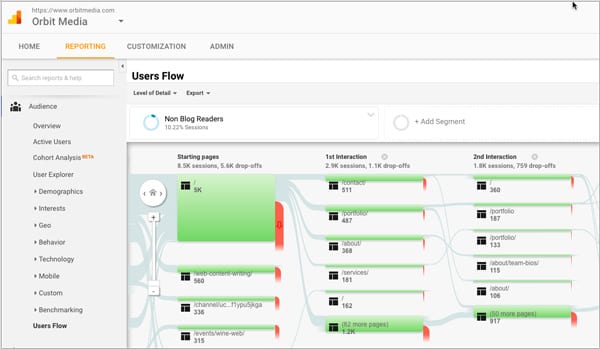 While it’s unsurprising that your home page should feature some of your best testimonials to make a strong first impression, it’s also a good idea to include testimonials on your about page. After all, why not showcase your best content in places where it will have the most visibility and impact? The key is to put the best stuff anywhere on your website where people are most likely to see it.
While it’s unsurprising that your home page should feature some of your best testimonials to make a strong first impression, it’s also a good idea to include testimonials on your about page. After all, why not showcase your best content in places where it will have the most visibility and impact? The key is to put the best stuff anywhere on your website where people are most likely to see it.
Put testimonials with keyphrases on pages that are optimized for that phrase.
Here’s a bonus tip that not only enhances your conversion rates but can also boost your website’s traffic. If the testimonial includes a target keyphrase or related words, it can increase the relevance of that page for the given phrase, which may positively impact the page’s search engine ranking.
 This dual benefit of improving both traffic and conversion rates is a powerful strategy.
This dual benefit of improving both traffic and conversion rates is a powerful strategy.
FAQs
Q1: Can I use a template for writing testimonials?
A: While templates can be helpful, it’s best to personalize your testimonials for authenticity.
Q2: How long should a testimonial be?
A: Testimonials should be long enough to convey your message but concise enough to maintain the reader’s interest.
Q3: Is it okay to include constructive criticism in a testimonial?
A: Absolutely, as long as it’s constructive and presented in a helpful manner.
Q4: Should I use the person’s or business’s name in my testimonial?
A: Yes, using their name adds credibility to your endorsement.
Q5: What if I don’t have much to say in a testimonial?
A: Focus on the most impactful aspects of your experience, even if it’s just a few sentences.
Q6: Can I update my testimonial later if my opinion changes?
A: Yes, it’s perfectly fine to update your testimonial to reflect your evolving opinion.
Conclusion
Writing effective testimonials is an art that can enhance your reputation and help others succeed. By focusing on authenticity, structure, and expert tips, you can create powerful endorsements that make a difference. So, the next time you’re asked to provide a testimonial, follow these guidelines, and you’ll be well on your way to crafting testimonials that leave a lasting impression.

 Where to use testimonials?
Where to use testimonials?

